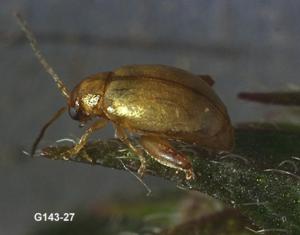CONTENTS
Identification
Management
Sampling
and Action Threshold
Development Model
Registered
Insecticides
References
[Insect
Management]
[Home]
|
|

Mint flea beetles overwinter as eggs in the soil near the crown of mint plants. Eggs hatch
early April through early May. Larvae feed initially on small mint roots and later tunnel
into rhizomes. Larval development is completed during late May and early June. Pupation is
in the soil near the rhizomes. The pupal stage is completed in about 3 to 4 weeks. Adults
begin emerging from the soil during early July. Damage to mint foliage fed upon by adults
is characteristic; the leaves appear riddled as if by shotgun pellets. Adult females
usually delay depositing eggs for 2 to 3 weeks after emergence. Females have wings, but
seldom disperse by flight. Males are incapable of flight. Therefore, dispersal is usually
slow and occurs by hopping or walking. At harvest, adults disperse to adjacent fields or
to margins of fields seeking uncut plants. Eggs may either be deposited in mint fields or
along field margins. Egg laying continues into the fall until the onset of freezing
temperatures. There is one complete generation each year. Planting from infested rootstock
is one of the principal ways new mint flea beetle infestations are established.

The use of degree-days (DD), using a base
temperature of 41ºF, accumulated from January 1, is an effective method of predicting the
occurrence of different life stages of mint flea beetle in the field (Morris,
1990). The following degree-day requirements may be used to predict the presence of
different stages of mint flea beetle in central Oregon:
Degree-day requirements for different stages of mint flea beetle:
1st instar larvae 405 DD
2nd instar larvae 575 DD
3rd instar larvae 775 DD
Prepupae
1045
DD
Pupae
1370 DD
Adults
1555 DD
Run the development model to
determine development of mint flea beetle in your area. |


